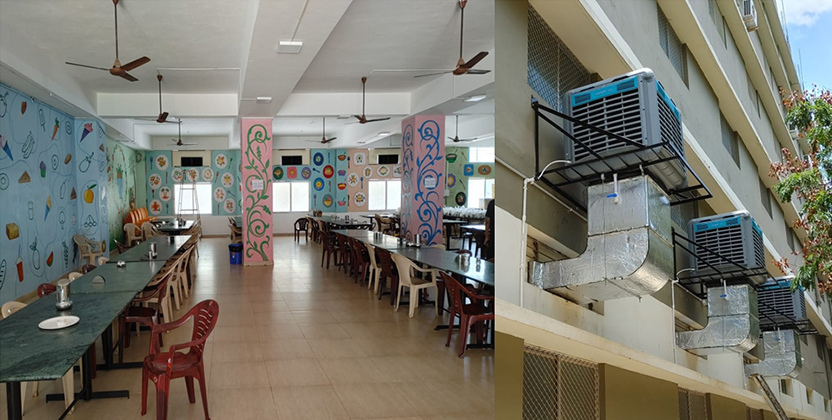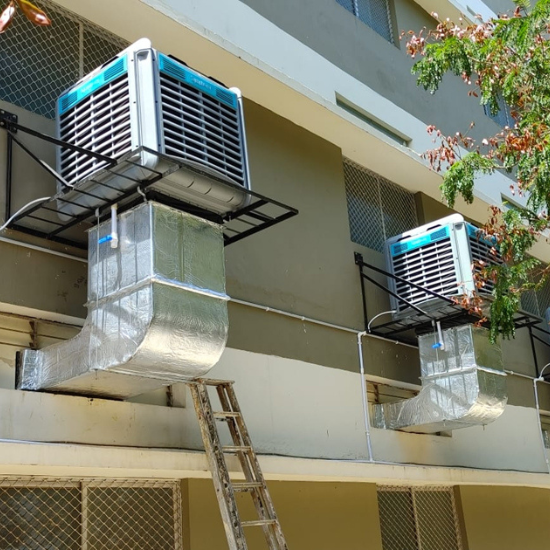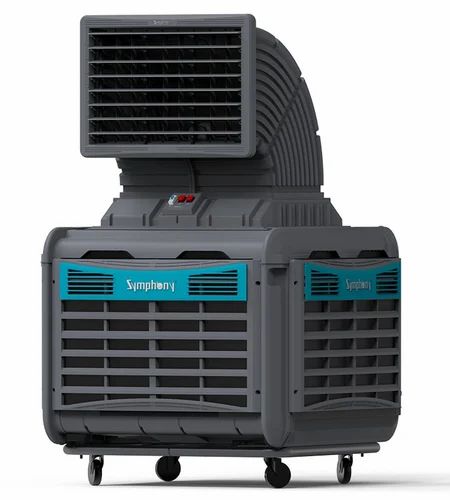Industrial Air Coolers to Optimize Airflow for Hotels & Cloud Kitchens

Before airflow optimization was addressed using Symphony industrial air coolers, many hotels and cloud kitchens in India and other tropical zones faced critical air management issues. From uncontrolled humidity to uneven air delivery, these issues affected not only operational efficiency but also hygiene, compliance, and guest experience.
This article outlines what problems existed, why they persisted, and how a shift to structured industrial cooling brought a practical and impactful change.
The Before Scenario: Airflow Challenges in Hotels and Cloud Kitchens
1. Stagnant Air in Hot Kitchen Zones
Prior to industrial cooling integration, cloud kitchens relied heavily on ceiling fans and exhaust systems. These setups were never enough to handle the intense heat and smoke generated across multiple cooking stations. The air would recirculate within the space, trapping hot air pockets.
In hotels, the problem was more spread out. Kitchens, service corridors, and utility areas had stale, unmoving air due to disconnected or underpowered ventilation systems.
Resulting issues:
- Heat stress for staff.
- Discomfort affecting speed and morale.
- Compromised food quality due to warm surroundings.
2. Inconsistent Airflow in Multi-Zone Facilities without Industrial Air Cooler Systems
Hotels often span across lobbies, kitchens, guest rooms, and large event spaces. Without a centralized industrial air cooler system designed for all zones, airflow became patchy. Some areas were over-ventilated, while others were stagnant.
Cloud kitchens set up in commercial complexes faced a similar challenge. One cooking bay might be properly vented, while another saw no air circulation at all.
Consequences:
- Foul odors pooling in corners.
- Unbearable humidity around dishwashing areas.
- Cross-zone air pressure mismatch affecting exhaust flow.

3. Inadequate Ventilation for Heat and Fume Extraction
Kitchen exhaust chimneys and overhead fans had one job - remove fumes. But without active air inflow, these systems created a vacuum, pulling in hot external air instead of circulating fresh air. It turned kitchen spaces into hotboxes.
In some hotels, ducted air conditioning units were misaligned with hot zones, focusing cool air on the wrong spaces. That only made the situation worse.
Outcomes:
- Condensation forming on ceilings.
- Mold and corrosion risks rising.
4. Overreliance on Inefficient ACs Instead of Industrial Cooling Systems
Many facilities, especially hotels, initially relied solely on centralized HVAC systems to regulate temperature. These systems weren't designed to tackle high-volume, heat-emitting environments like commercial kitchens.
Cloud kitchens, often budget-sensitive, tried splitting household ACs across stations - a workaround that failed under operational load.
Impact:
- Uneven cooling distribution.
- Frequent system overload and failures.
- Spiked energy costs without solving the core airflow issue.
Turning Point with Symphony Venti-Cool Industrial Coolers
The Symphony Venti-Cool, a high-capacity ducting-based industrial cooler, was introduced specifically to solve these kinds of challenges in real-world settings. These ventilation coolers brought focused, directional airflow to spaces where stagnant air was previously a daily concern.
The change wasn’t about just cooling - it was about restoring controlled, balanced air movement in high-demand zones. Unlike ceiling-mounted fans or exhaust-only designs, Symphony Venti-Cool offers high-volume airflow with active delivery via ducts.

Implementation: How Airflow Gets Optimized Using Industrial Cooling Solutions?
1. Industrial Cooling System Provides Balanced Circulation across Critical Areas
Symphony Venti-Cool models allow air to be delivered to multiple points through ducting. Kitchens now have air directed straight to cooking bays, washing zones, and packing stations. Hotels can route airflow to utility rooms, corridors, and even staff changing zones.
This eliminates air dead zones that had been persistent for previous years.
2. Simultaneous Air Inflow and Outflow via Air Cooler for Industrial Use
Instead of just removing hot air, the system introduces fresh, filtered air at high pressure. This enables a proper air exchange cycle. Hot air is pushed out naturally, while cooler air moves in - preventing vacuums and smoke build-up.
This directly tackles the earlier problems caused by one-sided ventilation.
3. Industrial Cooling System Reduces Thermal Layering in Vertical Spaces
Earlier, hot air would rise and form a heat cap near ceilings. This made upper spaces in commercial kitchens dangerously hot. With the industrial air cooler pushing dense air downwards through ducts, vertical layering was broken.
The entire room experiences uniform air temperature, reducing stress on people and equipment alike.
4. Reliable Performance without Energy Surges
Unlike HVACs or split ACs, the Venti-Cool system consumes less power but moves more air. It provides a continuous flow of cooled air, not refrigerant-based chilled air. This allows it to run longer without fluctuations or compressor overload.
Cloud kitchens can now see stability, and hotels can find relief from energy budget overruns.
5. Real-World Improvements with Industrial Cooling
Within weeks of deployment:
- Kitchens may report fewer staff complaints of heat exhaustion.
- Food preparation zones can maintain temperature better, improving shelf life.
- Utility areas in hotels stay odor-free and dry.
- Energy bills begin to stabilize across test locations.
- Equipment like refrigerators and ovens work more efficiently due to ambient air control.
This shift proves that air comfort isn’t a luxury - its operational infrastructure.
Conclusion
Optimizing airflow isn’t just about lowering temperature. It’s about regulating the health and functionality of every square foot in a high-activity environment.
The industrial air cooling systems of Symphony Venti-Cool redefine how air was managed in cloud kitchens and hotels previously. It transforms the environment from reactive cooling to proactive air control.
Whether it’s a compact industrial air cooler for home-style utility zones or a high-capacity air cooler for industrial use, these Symphony cooling machines are essential to ensuring performance, hygiene, and efficiency in every operational layer.
FAQs - Industrial Air Coolers for Hotels & Cloud Kitchens
Industrial air coolers provide high-volume airflow and targeted cooling, helping control temperature, humidity, and ventilation in busy environments.
It uses ducted airflow to deliver fresh, filtered air directly to heat zones, eliminating stagnant air and improving circulation.
Industrial coolers handle larger spaces and higher heat loads, while home coolers are meant for smaller, residential environments.


